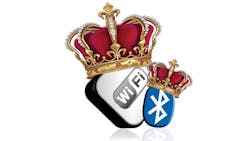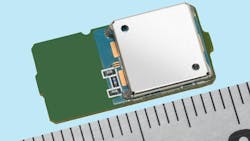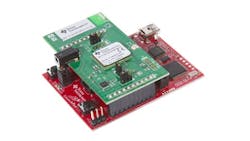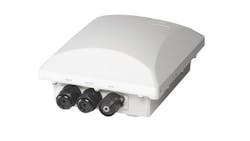This file type includes high resolution graphics and schematics.
With dozens of short-range wireless standards to choose from, engineers still defer to the two mainstays, Bluetooth and Wi-Fi. After more than 15 years, they continue to grow, improve, and provide new features and benefits. These amazingly useful technologies both use the 2.4-GHz industrial-scientific-medical (ISM) unlicensed spectrum. Wi-Fi also has access to the 5-GHz and 60-GHz ISM spectrum.
What’s New With Bluetooth?
The most recent version of Bluetooth, 4.0, incorporates all of its previous features but adds Bluetooth Low Energy (BLE). Also known as Bluetooth Smart, BLE uses a different set of technical and radio techniques to ensure very low power consumption compared to the original Bluetooth standard (see “Bluetooth’s Background,”
http://electronicdesign.com/communications/bluetooths-background).
BLE’s data protocol was changed to support low-duty-cycle transmissions or very short transmission bursts between long periods. The low duty cycle and extremely low-power sleep modes enable BLE products to operate for many years on a coin cell. BLE also provides a group of application programming interfaces (APIs) for fast and easy application development.
BLE still operates in the same ISM license-free 2.4- to 2.483-GHz frequency band as standard Bluetooth, but it uses a different frequency-hopping spread-spectrum (FHSS) scheme. Standard Bluetooth hops at a rate of 1600 hops per second over 79 channels that are 1 MHz wide. BLE FHSS uses 40 channels that are 2 MHz wide to ensure greater reliability over longer distances. Standard Bluetooth offers gross data rates of 1, 2, or 3 Mbits/s. BLE’s maximum rate is 1 Mbit/s with a net throughput of 260 kbits/s.
Additionally, BLE uses Gaussian frequency shift keying (GFSK) modulation. It offers a power output of 0 dBm (1 mW) and a typical maximum range of 50 meters. Security is via the 128-bit Advanced Encryption Standard (AES). An adaptive frequency-hopping technique that avoids interference, a 24-bit cyclic redundancy code (CRC), and a 32-bit message integrity check all improve link reliability. The most common network configurations are point-to-point (P2P) or star. Latency is only 6 ms.
Most low-power wireless networks are involved in consumer, medical, health, or sports and fitness applications. These mobile applications require small size and coin cell power that can function for years without attention.
Consumer applications include electronic leashes to locate people, animals, or things; proximity detection for use in identification, authentication, and wireless locks; RFID-like (radio-frequency identification) cases; automatic meter reading; toys; automotive applications such as On-Board Diagnostic II connector plug-ins; home-area networks; human interface device (HID) peripherals like mice and keyboards; and game controllers.
Medical and health care applications include heart-rate monitors, temperature monitors, instrumentation, and body-area networks. Similarly, sports and fitness applications include sports watches and monitors, heart-rate belts, bike computers, speed and distance monitoring, and fitness equipment.
BLE is not compatible with standard Bluetooth, though. It is a separate radio on standard Bluetooth 4.0 chips. BLE devices do not interoperate with classical Bluetooth products. But such interoperability could be implemented with a dual-mode IC that integrates a standard Bluetooth radio and a BLE radio, which can operate separately but not at the same time. They also can share an antenna. Dual-mode devices are available separately for low-power-only applications.
Bluetooth Smart Ready refers to the dual-mode chips of version 4.0. It handles previous versions of classic Bluetooth in addition to BLE. Bluetooth Smart is BLE only. It won’t connect with any other version of Bluetooth except for Smart Ready 4.0 or other BLE devices. Classic Bluetooth is compatible with previous versions and Smart Ready devices. It won’t connect with Smart devices.
Recent announcements from Apple, Google Android, and Microsoft (Windows 8) indicate software support for the new Bluetooth standards. This support will expedite connectivity with Smart devices to smart phones, tablets, and laptops.
Multiple vendors offer dual-mode and BLE chips, including Broadcom, CSR, Dialog Semiconductor, EM Microelectronics, Nordic Semiconductor, Texas Instruments, and the TTP Group. Nordic Semiconductor, for example, offers the nRF51822 BLE radio (Fig. 1).
Wi-Fi Review
Wi-Fi is the trade name of the IEEE’s wireless local-area network (WLAN) standard, designated 802.11. A suffix at the end indicates the standard version (see the table). 802.11n is the current most widely implemented variant found in Wi-Fi access points, hotspots, and routers. Wi-Fi is also in most laptops, all tablets and smart phones, and smart TV sets.
The 802.11 standard defines both a physical layer (PHY) and a media access control (MAC) layer in the networking scheme. While the MAC tends to remain mostly the same, the PHY changes to include the most recent wireless technology for greater speed and link reliability.
The first generation 11b showed up in 1997 and uses direct sequence spread spectrum (DSSS) to achieve data rates to 11 Mbits/s in a 20-MHz channel in the 2.4-GHz ISM radio band. With the growth of the Internet, that low speed soon became a disadvantage.
The second-generation 802.11a came along in 1999. It was the first to use the 5-GHz ISM band and orthogonal frequency division multiplexing (OFDM) with 64 subcarriers spaced 312.5 kHz apart. Channel bandwidth was 20 MHz, and binary phase-shift keying (BPSK), quadrature phase-shift keying (QPSK), 16-phase quadrature amplitude modulation (16QAM), and 64-state quadrature amplitude modulation (64QAM) types were defined, permitting the data rate to increase to a maximum of 54 Mbits/s.
While the 802.11a version was more robust because of the OFDM characteristics that mitigated multipath reflections and the 5-GHz assignment meant less interference, the higher frequency still limited the range. This version was never too popular despite its advantages.
The big breakthrough came when the 802.11g standard was approved in 2003. It is essentially the same as 11a but operates in the 2.4-GHz band. Using the same OFDM and modulation options, it too can deliver up to 54 Mbits/s. It was immediately popular because the many IC companies competing for the business brought chip prices very low.
The current 11n standard is a further improvement over 11a/g. It adds 40-MHz channels and multiple-input multiple-output (MIMO) features to the OFDM, allowing data rates to increase to as much as 600 Mbits/s.
This file type includes high resolution graphics and schematics.
MIMO uses multiple receivers, transmitters, and antennas to achieve spatial division multiplexing (SDM). SDM transmits fast multiple data streams concurrently within the same 20- or 40-MHz channel bandwidth. Pre-coding and post-decoding as well as unique path characteristics distinguish the data streams. The data rate then can be multiplied by a factor roughly equal to the number of data streams.
The 11n MIMO standard permits up to four transmit and four receive channels (4x4), although 1x2, 2x2, and 3x3 versions are more widely used. The 600-Mbit/s data rate is achieved using 4x4 MIMO with 64QAM in a 40-MHz channel.
What makes 11n so popular is its ability to carry video, enabling wireless connectivity in TV sets, DVD players, and other video equipment. Using compressed video (H.264, MPEG4, etc.) full HD signals can be transmitted reliably with the higher levels of MIMO.
The WLAN space is dominated by 11n Wi-Fi, which is available in all smart phones, tablets, and laptops. It also is the wireless technology of most hotspots and access points, including millions of home wireless routers. It’s increasingly being embedded in other consumer electronics. And, it’s backwards compatible with previous standards, allowing 802.11a/g equipment to be used.
The latest version of the standard is 802.11ac. It isn’t fully ratified yet, but it’s essentially complete. Finalization is expected in 2014. It uses the 5-GHz ISM band only for minimum interference and maximum available bandwidth. Furthermore, it continues the use of MIMO and OFDM. Some key changes boost theoretical data rate in excess of 3 Gbits/s, depending on modulation, channel bandwidth, and MIMO configuration. The primary changes are its 80- and 160-MHz wide channels in addition to the usual 40-MHz channel.
As the bandwidth increases, so does the number of OFDM subcarriers to a maximum of 512 at 160-MHz bandwidth. OFDM also adds 256QAM, which further boosts data rate. Finally, 11ac defines a greater number of MIMO versions with a maximum of an 8x8 configuration. A multi-user version, MU-MIMO, is defined as well. The standard additionally supports coexistence and compatibility with previous 11a and 11n devices. Transmit beamforming is an option to extend range and ensure link reliability.
Products for 11ac are emerging. Routers and access points are showing up, but few user devices include it. But because of its many advantages in speed and freedom from interference, you will eventually see 11ac capability not only in laptops but also tablets and smart phones.
Another recent version of Wi-Fi, 802.11ad, uses the 60-GHz ISM band. It is backwards compatible with all previous versions, including 11a/b/g/n/ac, as the MAC layers of the protocol are similar. The 11ad version is also known by its trade name, WiGig. The Wireless Gigabit (WiGig) Alliance, the trade association supporting and promoting 11ad, recently merged with the Wi-Fi Alliance (see “The Wi-Fi Alliance Ensures Compatibility,”
http://electronicdesign.com/communications/wi-fi-alliance-ensures-compatibility).
WiGig uses the unlicensed ISM 60-GHz band from 57 to 64 GHz, dividing it into four 2.16-GHz bands. Its OFDM primary modulation scheme can support up to 7 Gbits/s, making it one of the fastest wireless technologies available. A single-carrier mode uses less power and is a better fit for some portable handheld devices, delivering up to 4.6 Gbits/s. Uncompressed video can be transmitted at both speeds. The WiGig specification also provides AES security.
Because of the small antenna size at 60 GHz, gain antennas are normally used to boost signal power and range. The maximum typical range is 10 meters. WiGig products use antenna arrays that can provide beamforming. This adaptive beamforming permits beam tracking between the transmitter and receiver to ensure that obstacles can be avoided and speed maximized even under changing environmental conditions.
One clever feature of the standard is its use of a protocol adaption layer (PAL). This software structure talks to the MAC layer and allows simplified wireless implementation of other fast standard interfaces like USB, HDMI, DisplayPort, and PCI Express.
Wi-Fi continues to be one of the most widely used wireless technologies in history. More than 1 billion Wi-Fi enabled devices were shipped in 2011, and those shipments are expected to double by 2015. Many of the new devices in the works are related to consumer media products, health/fitness/medical, automotive, smart meters, and automation products.
What’s New With Wi-Fi?
The IEEE 802.11 Working Groups keep a running agenda of development. They work on the next major standard versions as well as many additions and improvements to the basic standards. The most significant standards include:
• 802.11e: provides quality-of-service (QoS) features that allow Voice over Internet Protocol (VoIP) and other critical services to be carried over Wi-Fi
• 802.11i: provides full security for Wi-Fi in the form of Wired Equivalent Privacy (WEP), Wireless Protected Access (WPA), and Wi-Fi Protected Access 2 (WPA2)
• 802.11s: brings automatic ad hoc mesh networking to Wi-Fi
• 802.11u: a protocol between access points and clients that permits internetworking with support for authentication, authorization, and accounting with network selection, encryption policy enforcement, and resource management; facilitates automatic connections and network handoffs
• 802.11y: brings Wi-Fi to the 3650- to 3700-MHz band
One of the most interesting new versions is the 802.11p standard, which will be deployed in V2x or vehicle-to-vehicle (V2V) and vehicle-to-infrastructure (V2I) systems. These systems are part of the proposed Intelligent Telecommunications System (ITS), which provides safety and traffic information to vehicles using telematics. Called the Dedicated Short Range Communications (DSRC) wireless system, this standard is similar to the 802.11a Wi-Fi standard.
The Dedicated Short-Range Communications (DSRC) system uses the IEEE 802.11p standard and a protocol known as Wireless Access in Vehicular Environments (WAVE). The DSRC is assigned a 75-MHz segment of spectrum from 5.85 to 5.925 GHz. There are seven 10-MHz channels designated by even numbers from 172 to 184. These channels are half the size of a standard 20-MHz 802.11 channel to minimize Doppler shift and multipath fading. A European version of the system is assigned 50 MHz of bandwidth for five channels.
The spectrum permits vehicle and roadside unit (RSU) infrastructure radios to form vehicular ad hoc networks (VANETs). These dynamic networks will provide short-lived intermittent connectivity to implement various safety applications for collision avoidance and road safety. Connections are automatic. The 802.11p standard radio is half duplex with a data rate in the 6- to 27-Mbit/s range and has an estimated maximum range of 300 meters (1 km).
The WAVE protocol uses the standard PHY and MAC layer of the 802.11a standard but uses the IEEE 1609 standard family for the upper layers including a MAC extension, a logical link control (LLC) layer, network and transport layers that include IPv6 with User Datagram Protocol (UDP) and Transmission Control Protocol (TCP), and an upper message application layer. The 1609.2 standard also provides security. Several different types of short message formats have been developed for different conditions.
Then there are projects still being developed in the various Task Groups, such as 802.11ah. This modification to existing standards would allow operation in sub-1-GHz bands to extend the range and implement applications such as smart meters. Another interesting new standard in development, 11af, targets the TV white space opportunity. It seeks to meet the legal requirements for channel access and coexistence in the TV white space bands.
White space refers to the unused TV channels that are present around the U.S. The idea is to use the vacant channels for short-range data transmission. The number and location of these unused channels vary widely, so cognitive radio techniques are used to indentify vacant channels that are least likely to interfere with the TV channels. A national database of TV station locations and open channels lets the cognitive radio hop to an appropriate channel. You will hear of 802.11af referred to as Super Wi-Fi or White-Fi.
The 802.11af standard defines the PHY and MAC layer for white space operation. While the standard is still under development, the basic features are defined. It uses the TV channels in the 470- to 710-MHz range, or UHF TV channels 20 to 31. The channel bandwidth is 6 MHz. The basic modulation scheme is OFDM with BPSK, QPSK, 16QAM, or 64QAM. The transmit power level is 20 dBm, and the antenna gain is 0 dBi.
These low frequencies offer exceptional range, far greater than other Wi-Fi versions in the 2.4- and 5-GHz range. Ranges to several miles are possible. Data rates will vary depending on modulation type, range, and other factors. Equipment for white spaces initially will use proprietary wireless standards. The 802.11af standard will be used with these early systems as well as another IEEE standard, 802.22.
A Wi-Fi Future
While Wi-Fi appears to be everywhere now, soon it will be even more widespread. It is already available on many airlines so passengers can connect to the Internet in flight. It is used in printers and cameras. But that’s not all. Wi-Fi also is targeting the machine-to-machine (M2M) field and the Internet of Things (IoT).
Wi-Fi appears to be emerging as the wireless technology of choice in home networks and even appliances. ZigBee and Z-Wave wireless devices are already in the home, and they require some kind of gateway to connect to the Internet. Since many homes have a Wi-Fi network, it is a natural choice for home networks. Whirlpool, LG, and other companies use Wi-Fi to collect usage data on their refrigerators, washers, and other appliances. Some appliance makers offer a smart-phone app that lets the owner see energy consumption, usage, maintenance, and other data on each connected appliance.
Texas Instruments designed its SimpleLink Wi-Fi CC3000 BoosterPack to help engineers develop Wi-Fi enabled IoT products. It offers simplified Wi-Fi connectivity for microcontroller-based systems and works with TI’s MSP430 and TivaC series for MCUs. The TI CC3000 module is a self-contained wireless network processor that simplifies the implementation of Internet connectivity (Fig. 2). Similarly, Broadcom’s Wireless Internet Connectivity for Embedded Devices (WICED) platform can be used to create IoT products using Wi-Fi and/or Bluetooth Smart technology.
Wi-Fi also is increasingly being deployed in factory automation, petrochemical plants, and other challenging RF environments. Enterprise-class throughput is combined with a broad operating temperature and rugged packaging to provide a reliable wireless access point for industrial users.
Carrier-grade Wi-Fi refers to ruggedized access points (APs) with special performance characteristics. The Ruckus Wireless ZoneFlex 7782 outdoor AP features 802.11n operation in the 2.4- and 5-GHz bands (Fig. 3). Its internal smart antennas provide both 120° and 30° patterns for improved capacity and performance.
The latest and most ambitious use of Wi-Fi is in offloading data from cellular networks. Cellular carriers are trying hard to handle the big explosion of data, like video to smart phones and tablets. The ongoing upgrade to 4G LTE is going well but takes time and capital investment. In many instances, the networks are not keeping up with the demand for speed.
Wi-Fi networks are being implemented to handle the load. When a cellular connection cannot handle the speed, the user is passed off to a nearby Wi-Fi network if one is available. Many cellular carriers are adding or expanding their own Wi-Fi networks to ensure that the offload process can occur seamlessly. The offload is not fully automatic, but work is in progress to make that happen. Carriers are discovering that Wi-Fi offload provides cheaper and faster service than LTE. Look for more hardened, carrier-grade Wi-Fi as cellular providers implement the offload option.
This file type includes high resolution graphics and schematics.
About the Author

Lou Frenzel
Technical Contributing Editor
Lou Frenzel is a Contributing Technology Editor for Electronic Design Magazine where he writes articles and the blog Communique and other online material on the wireless, networking, and communications sectors. Lou interviews executives and engineers, attends conferences, and researches multiple areas. Lou has been writing in some capacity for ED since 2000.
Lou has 25+ years experience in the electronics industry as an engineer and manager. He has held VP level positions with Heathkit, McGraw Hill, and has 9 years of college teaching experience. Lou holds a bachelor’s degree from the University of Houston and a master’s degree from the University of Maryland. He is author of 28 books on computer and electronic subjects and lives in Bulverde, TX with his wife Joan. His website is www.loufrenzel.com.




